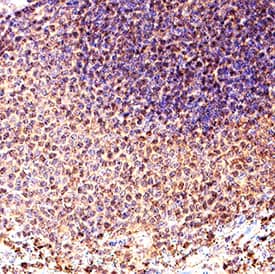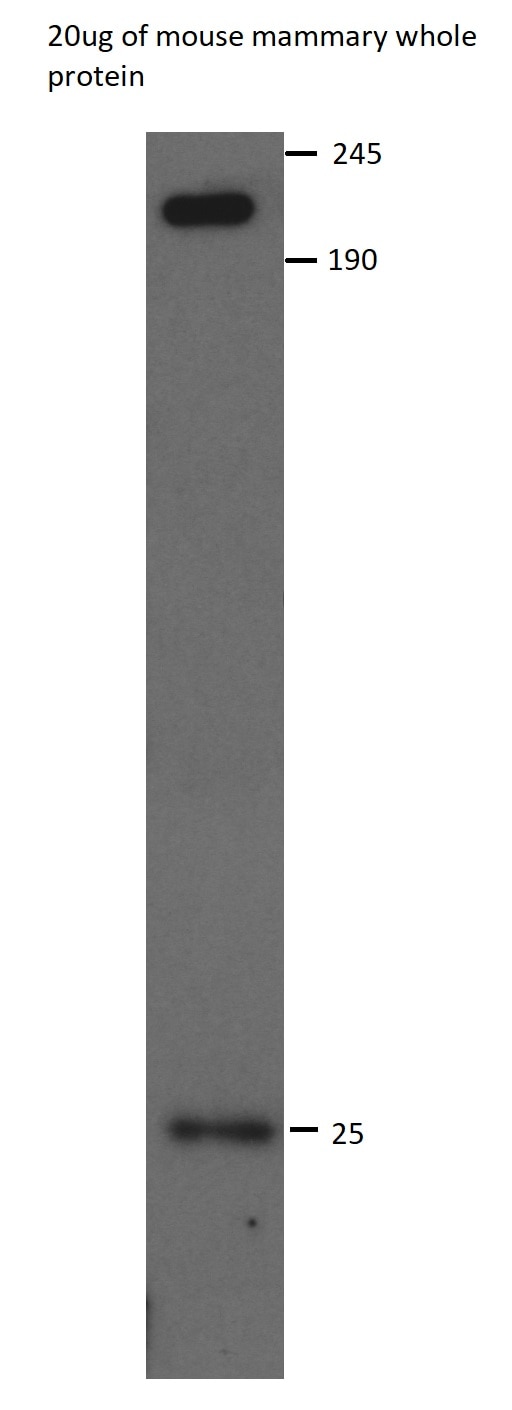Mouse TCF7/TCF1 Antibody Summary
Gly61-Gly116
Accession # Q00417
Customers also Viewed
Applications
Please Note: Optimal dilutions should be determined by each laboratory for each application. General Protocols are available in the Technical Information section on our website.
Scientific Data
 View Larger
View Larger
Detection of Mouse TCF7/TCF1 by Western Blot. Western blot shows lysates of EL-4 mouse lymphoblast cell line and mouse thymus tissue. PVDF membrane was probed with 1 µg/mL of Rat Anti-Mouse TCF7/TCF1 Monoclonal Antibody (Catalog # MAB8224) followed by HRP-conjugated Anti-Rat IgG Secondary Antibody (Catalog # HAF005). Specific bands were detected for TCF7/TCF1 at approximately 30-50 kDa (as indicated). This experiment was conducted under reducing conditions and using Immunoblot Buffer Group 1.
 View Larger
View Larger
Detection of TCF7/TCF1 in EL‑4 Mouse Cell Line by Flow Cytometry. EL-4 mouse lymphoblast cell line was stained with Rat Anti-Mouse TCF7/TCF1 Monoclonal Antibody (Catalog # MAB8224, filled histogram) or isotype control antibody (Catalog # MAB0061, open histogram), followed by Allophycocyanin-conjugated Anti-Rat IgG Secondary Antibody (Catalog # F0113). To facilitate intracellular staining, cells were fixed with paraformaldehyde and permeabilized with saponin.
Preparation and Storage
- 12 months from date of receipt, -20 to -70 °C as supplied.
- 1 month, 2 to 8 °C under sterile conditions after reconstitution.
- 6 months, -20 to -70 °C under sterile conditions after reconstitution.
Background: TCF7/TCF1
TCF7 (Transcription factor 7), also called TCF1 (T cell factor 1) is a member of the lymphoid enhancer binding factor family of proteins that is expressed in thymocytes and mature T cells. In resting cells, TCF family members are transcriptional repressors, and are 25‑32 kDa in size. Following activation, the large TCF7/TCF1 isoform (isoform 2, chosen as 'canonical') predominates (419 amino acids, 42‑50 kDa), and serves a transcriptional activator function. The use of an alternate start site at Met116 seems to characterize repressor isoforms. Within aa 61-116 of the large form, mouse TCF7/TCF1 shares 77% aa sequence identity with human TCF7/TCF1.
Product Datasheets
Citations for Mouse TCF7/TCF1 Antibody
R&D Systems personnel manually curate a database that contains references using R&D Systems products. The data collected includes not only links to publications in PubMed, but also provides information about sample types, species, and experimental conditions.
3
Citations: Showing 1 - 3
Filter your results:
Filter by:
-
From pseudo to real-time dynamics of T cell thymic differentiation
Authors: Avishai Gavish, Benny Chain, Tomer M. Salame, Yaron E. Antebi, Shir Nevo, Shlomit Reich-Zeliger et al.
iScience
-
A beta -catenin-driven switch in TCF/LEF transcription factor binding to DNA target sites promotes commitment of mammalian nephron progenitor cells
Authors: Qiuyu Guo, Albert Kim, Bin Li, Andrew Ransick, Helena Bugacov, Xi Chen et al.
eLife
-
Single Extracellular Vesicle Protein Analysis Using Immuno‐Droplet Digital Polymerase Chain Reaction Amplification
Authors: Jina Ko, Yongcheng Wang, Jonathan C. T. Carlson, Angela Marquard, Jeremy Gungabeesoon, Alain Charest et al.
Advanced Biosystems
FAQs
No product specific FAQs exist for this product, however you may
View all Antibody FAQsIsotype Controls
Reconstitution Buffers
Secondary Antibodies
Reviews for Mouse TCF7/TCF1 Antibody
Average Rating: 3 (Based on 1 Review)
Have you used Mouse TCF7/TCF1 Antibody?
Submit a review and receive an Amazon gift card.
$25/€18/£15/$25CAN/¥75 Yuan/¥2500 Yen for a review with an image
$10/€7/£6/$10 CAD/¥70 Yuan/¥1110 Yen for a review without an image
Filter by:
Nature of the bands is unclear, but in some instances antibody appears to give bands of the predicted size. 20ug of protein/lane. Dilution 1:1000, blocked with milk in TBST.
Appears to work on IF(tissue cryosections)


















